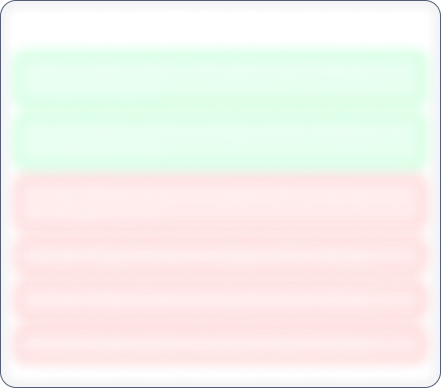Get 50% OFF This Monsoon!
Bilcare

No Data Available
Investor Sentiment
Bilcare Share price and Fundamental Analysis
Key Metrics
Stock Returns
Stock Heatmap

No Stocks
Smart Score

Unlock Smart Score
See Detailed Analysis & Insights


Unlock Insights
See Detailed Analysis & Insights
Technicals
Returns Calculator
If you would have investedResearch Report
No Research Report
Corporate Action
Financials
Key Ratios
ROE
Avg ROE (3 Yrs) : NaN%
ROCE
Avg ROCE (3 Yrs) : NaN%
ROA
Avg ROA (3 Yrs) : NaN%
NPM
Avg NPM (3 Yrs) : NaN%
Dividend History
5 Year FactSheet
Documents

No Data Available
News
Bilcare Management and History
Company Management


Unlock Management Data
See Detailed Analysis & Insights
Company History
Bilcare Ltd is a research-based organization primarily engaged in manufacturing specialty pharmaceutical packaging barrier films. The company provides pharmaceutical research services, clinical services and packaging systems and material. The company's key products include packaging films, aluminum foils, wrap systems, cold formed blisters, closures and containers, and paper composites. They also offer research services, including preformulation studies, formulation development, analytical research, stability studies, packaging audit and packaging development and design.
Bilcare Ltd was incorporated on July 1987 as Bhandari Paper Products Pvt Ltd and converted into a public limited company on Oct. 27, 1994. The name of the company was changed to BI Ltd in the year 2001 and further the name was changed to Bilcare Ltd on October 1, 2003. The company's plant at Rajgurunagar in Pune is one of its kinds in Asia and the eighth plant of its kind in the world.
During the year 1997-98, company completed the project of Paper Tube Plant at Patalganga in Maharashtra. During the year 1999-2000, German Investment and Development company namely DEG - Deutsche Investitions - Und Entwicklungsgesellschaft MBH has subscribed to 21% of the share capital of PT Bhandari Mishindo, a subsidiary of the company. During the year 2002-03, the company introduced seven new unique products for the pharma sector namely Nova, Patina, Ultra, Excel, Super Zing and Venus.
During the year 2003-04, the company hived off their Biltube Division in order to focus their core business of manufacture of pharma packaging and research. Also, PT Bhandari Mishindo, a subsidiary company in Indonesia which was formed as an integral part of the Biltube Division was ceased to be a subsidiary of the company. Also, the company promoted Bilcare Singapore Pte Ltd as a wholly owned subsidiary of the company during the year.
In July 2005, Bilcare Singapore Pte Ltd, a wholly owned subsidiary of the company acquired pharma research and clinical services business in USA. Thus Bilcare Inc became a subsidiary of the company. In October 2005, the company unveiled their clinical services facility in Pune. This facility will support the pharma companies in packaging and distribution of their clinical supplies and integrate their global clinical trial requirements efficiently.
In September 2006, the company acquired DHP Ltd, a UK-based Clinical Trials Services provider through Bilcare (UK) Ltd, a wholly owned subsidiary of Bilcare Singapore Pte Ltd. In May 2007, Bilcare Research announced the launch of the Bilcare Research Academy in partnership with Association of Clinical Research Professionals (ACRP), US. The academy shall open 25 centers in India and other parts of Asia by 2010.
In January 2008, Bilcare Singapore has bought 100% of Singular ID, the provider of integrated high technology enterprise brand security system, for a consideration of Singapore Dollar 19.58 million. Bilcare Singapore is a wholly owned subsidiary of the company. In July 2008, Bilcare Ltd and USA based MeadWestvaco Corp jointly acquired the pharmaceutical packaging Company International Labs of St. Petersburg, Florida, USA.
Bilcare Share Price
Bilcare share price reflects investor sentiment toward the company and is impacted by various factors such as financial performance, market trends, and economic conditions. Share price is an indicator which shows the current value of the company's shares at which buyers or sellers can transact.
Bilcare Market Cap
Market capitalization of Bilcare indicates the total value of its outstanding shares. Marketcap is calculated by multiplying share price and outstanding shares of the company. It is a helpful metric for assessing the company's size and market Valuation. It also helps investors understand how Bilcare is valued compared to its competitors.
Bilcare PE Ratio
Bilcare PE ratio helps investors understand what is the market value of each stock compared to Bilcare 's earnings. A PE ratio higher than the average industry PE could indicate an overvaluation of the stock, whereas a lower PE compared to the average industry PE could indicate an undervaluation.
Bilcare PEG Ratio
The PEG ratio of Bilcare evaluates its PE ratio in relation to its growth rate. A PEG ratio of 1 indicates a fair value, a PEG ratio of less than 1 indicates undervaluation, and a PEG ratio of more than 1 indicates overvaluation.
Bilcare ROE (Return on Equity)
Return on Equity (ROE) measures how effectively Bilcare generates profit from shareholders' equity. A higher ROE of more than 20% indicates better financial performance in terms of profitability.
Bilcare ROCE (Return on Capital Employed)
Return on Capital Employed (ROCE) evaluates the profitability of Bilcare in relation to its capital employed. In simple terms, ROCE provides insight to investors as to how well the company is utilizing the capital deployed. A high ROCE of more than 20% shows that the business is making profitable use of its capital.
Bilcare Total Debt
Total debt of Bilcare shows how much the company owes to either banks or individual creditors. In simple terms, this is the amount the company has to repay. Total debt can be a very useful metric to show the financial health of the company. Total debt more than equity is considered to be a bad sign.
Bilcare Debt to Equity Ratio
The Debt-to-Equity (DE) ratio of Bilcare compares its total debt to shareholders' equity. A higher Debt to Equity ratio could indicate higher financial risk, while a lower ratio suggests that the company is managing its debt efficiently.
Bilcare CAGR (Compound Annual Growth Rate)
CAGR shows the consistent growth rate of Bilcare over a specific period, whether it is over a month, a year, or 10 years. It is a key metric to evaluate the company’s long-term growth potential. Main metrics for which CAGR is calculated are net sales, net profit, operating profit, and stock returns.
Bilcare Technical Analysis
Technical analysis of Bilcare helps investors get an insight into when they can enter or exit the stock. Key components of Bilcare Technical Analysis include:
Support Levels (S1, S2, S3)
There are usually multiple support levels, but the main support levels for a stock are S1, S2, S3. Support levels indicate price points where stock might get support from buyers, helping the stock stop falling and rise.
Resistance Levels (R1, R2, R3)
There are usually multiple resistance levels, but the main resistance levels for a stock are R1, R2, R3. Resistance levels represent price points where Bilcare shares often struggle to rise above due to selling pressure.
Bilcare Dividends
Dividends refer to the portion of the company’s profits distributed to its shareholders. Dividends are typically paid out in cash and reflect Bilcare ’s financial health and profitability.
Bilcare Bonus Shares
Bonus shares are usually given by companies to make the stock more affordable, increase liquidity, boost investor confidence, and more.
Bilcare Stock Split
Stock split increases the number of its outstanding shares by dividing each existing share into multiple shares. When the company offers a stock split, the face value of the stock reduces in the same proportion as the split ratio.
Bilcare Financials
The financials of Bilcare provide a complete view to investors about its net sales, net profit, operating profits, expenses, and overall financial health. Investors can analyze financial data to assess the company’s stability and also understand how the company has been growing financially.
Bilcare Profit and Loss Statements
The profit and loss statement of Bilcare highlights its net sales, net profit, total expenditure, and operating profits in the current financial year. This Profit and Loss statement is crucial for evaluating the profitability and financial stability of Bilcare .
Bilcare Balance Sheet
The balance sheet presents a snapshot of Bilcare ’s assets, liabilities, and equity of shareholders, providing insights into the financials of the company.
Bilcare Cashflow Statements
Cashflow statements track the company's cash inflows and outflows over a period. It is an essential tool for understanding how well the company manages its liquidity and finances.


